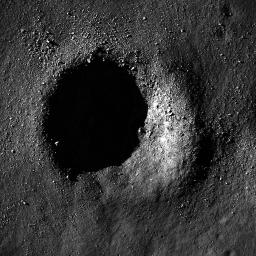
|
Bouldery Crater near Mare Australe
- Click the image above for a larger view
- Full-Res JPEG (1000 x 1000) (296.7 kB)
- Full-Res TIFF (1000 x 1000) (1.0 MB)
Caption:
Low Sun image of a fresh crater in the lunar highlands. Boulders are scattered within and around the 550 m crater. Image width is 950m, LROC NAC M150062296R.
Small craters on the Moon come in a variety of morphologies, and knowing how they differ is key to understanding their formation. This crater (51.42°S, 68.73°E) is surrounded with a high density of boulders. Was this crater formed by a primary or secondary impact? When a bolide (anything that impacts a planet, usually an asteroid or comet) impacts a more coherent material (solid rock for example), the ejecta contains a high percentage of boulders. So the boulders seen above could indicate a stronger subsurface. While primary bolides typically impact the Moon at speeds of 15-20 km/s, secondary impacts occur at much slower speeds. Any ejecta traveling faster than the escape velocity (2.38 km/s) will not impact the Moon. Because of the lower speed, ejecta impacts the Moon with less energy, which could lead to a smaller and more bouldery crater if the ejecta itself was a large piece of solid rock that shattered upon impact. In either case, these boulders would make excellent targets for sample return so that scientists can better understand how to definitively tell the difference between primary and secondary craters.
Background Info:
NASA's Goddard Space Flight Center built and manages the mission for the Exploration Systems Mission Directorate at NASA Headquarters in Washington. The Lunar Reconnaissance Orbiter Camera was designed to acquire data for landing site certification and to conduct polar illumination studies and global mapping. Operated by Arizona State University, LROC consists of a pair of narrow-angle cameras (NAC) and a single wide-angle camera (WAC). The mission is expected to return over 70 terabytes of image data.
Cataloging Keywords:
| Name | Value | Additional Values |
|---|---|---|
| Target | Moon | |
| System | Earth | |
| Target Type | Satellite | |
| Mission | Lunar Reconnaissance Orbiter (LRO) | |
| Instrument Host | Lunar Reconnaissance Orbiter | |
| Host Type | Orbiter | |
| Instrument | Lunar Reconnaissance Orbiter Camera (NAC) | |
| Detector | Narrow Angle Camera (NAC), Wide Angle Camera (WAC) | |
| Extra Keywords | Asteroid, Comet, Crater, Grayscale, Impact | |
| Acquisition Date | ||
| Release Date | 2011-04-13 | |
| Date in Caption | ||
| Image Credit | NASA/GSFC/Arizona State University | |
| Source | photojournal.jpl.nasa.gov/catalog/PIA14421 | |
| Identifier | PIA14421 | |
